
The year 2022 has witnessed one of the fastest valuation de-ratings on record, as interest rates have risen and growth concerns built.
The equity markets (and sectors) whose valuations were most expensive going into this year have been hit hardest by the equity drawdown. Slowing economic growth, elevated inflation, tighter monetary policy and heightened geopolitical risks have all taken their toll on financial markets. The midyear reprieve in risk sentiment was short-lived, and most major market indices remain in the red year to date. The question facing investors is whether the latest sell-off has pushed valuations to levels that represent an attractive buying opportunity.
US Valuation Multiples |
Global Ex US Valuation Multiples |
Australia Valuation Multiples |
|||||||
| Long-term Average* | Latest | Recent Peak** | Long-term Average* | Latest | Recent Peak** | Long-term Average* | Latest | Recent Peak** | |
| 12m Fwd Price to Earnings | 16.5 | 17.7 | 22.7 | 13.6 | 11.9 | 16.9 | 14.8 | 14 | 20.1 |
| Dividend Yield | 1.9 | 1.7 | 1.5 | 3.1 | 3.4 | 2.6 | 3.9 | 4.5 | 2.9 |
| Price to Book | 2.6 | 3.6 | 3.8 | 1.6 | 1.5 | 1.7 | 2 | 1.8 | 2.1 |
| Price to Cash Flow | 10.7 | 13 | 15.8 | 8.2 | 7.8 | 9.7 | 9.9 | 9.7 | 12.7 |
*June 1992 - August 2022 **December 2020
Source: Refinitiv, Wilsons.
What Can We Learn from Valuations?
Global Q2 earnings held up surprisingly well, and 1-year forward estimates are holding up despite input cost inflation and supply chain challenges. This means that, so far, the decline in equities this year is coming almost entirely from lower valuations – a long-term positive.
Valuations are a key signal for medium/longer-term-focused investors. They are an important forecaster of long-term returns and can provide useful signals at extremes, while over shorter periods of time, economic, momentum and behavioural factors can push markets away from fair value for extended periods. In other words, valuations provide important insight over the long-term but are not necessarily a good timing tool.
On a forward price-to-earnings (PE) ratio basis, US valuations have de-rated significantly, down 25% from the peak in December 2020. They are now nearing fair value, although the US still looks marginally expensive. Other valuation measures such as price-to-book, price-to-cashflow and dividend yield tell a similar story. Relative to prevailing bond yields, US equities now look fair value. Global equities also experienced a similar pullback and now look undervalued relative to their long-term average and to the US, although cyclical earnings risks are likely higher.
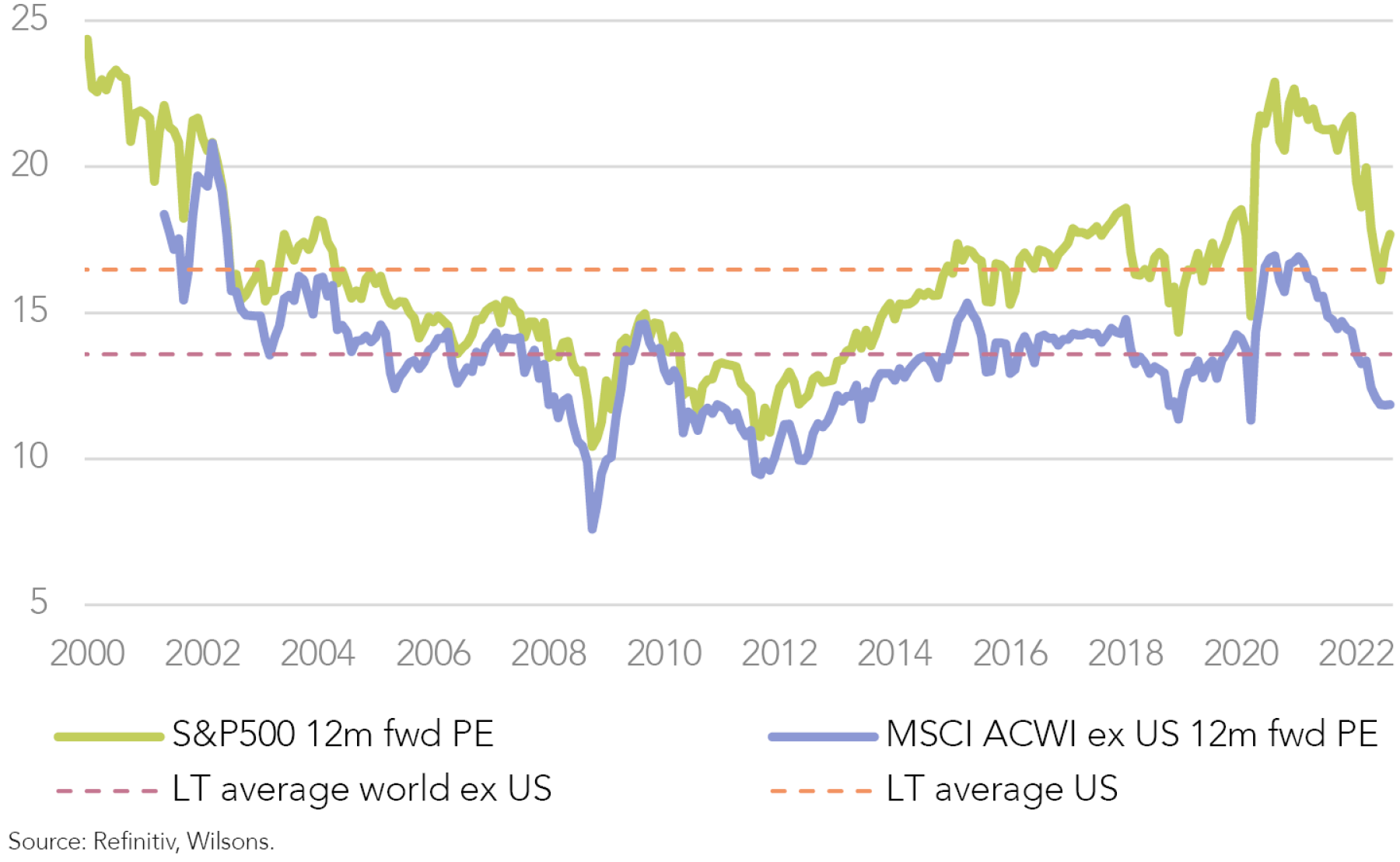
US Earnings Estimates Appear Overly Optimistic
While 2022 has delivered a large valuation reset, US valuations are not yet sufficiently attractive for investors to position too bullishly, given what seem to be overly optimistic 1-year forward earnings estimates. Consensus forecasts for US corporate earnings for full-year 2022 stand at 9%, and average 8.5% over the next 2 years, which appears at odds with weakening underlying economic conditions. We expect those projections will be revised lower, as they more accurately factor in the prospect of a significant slowdown.
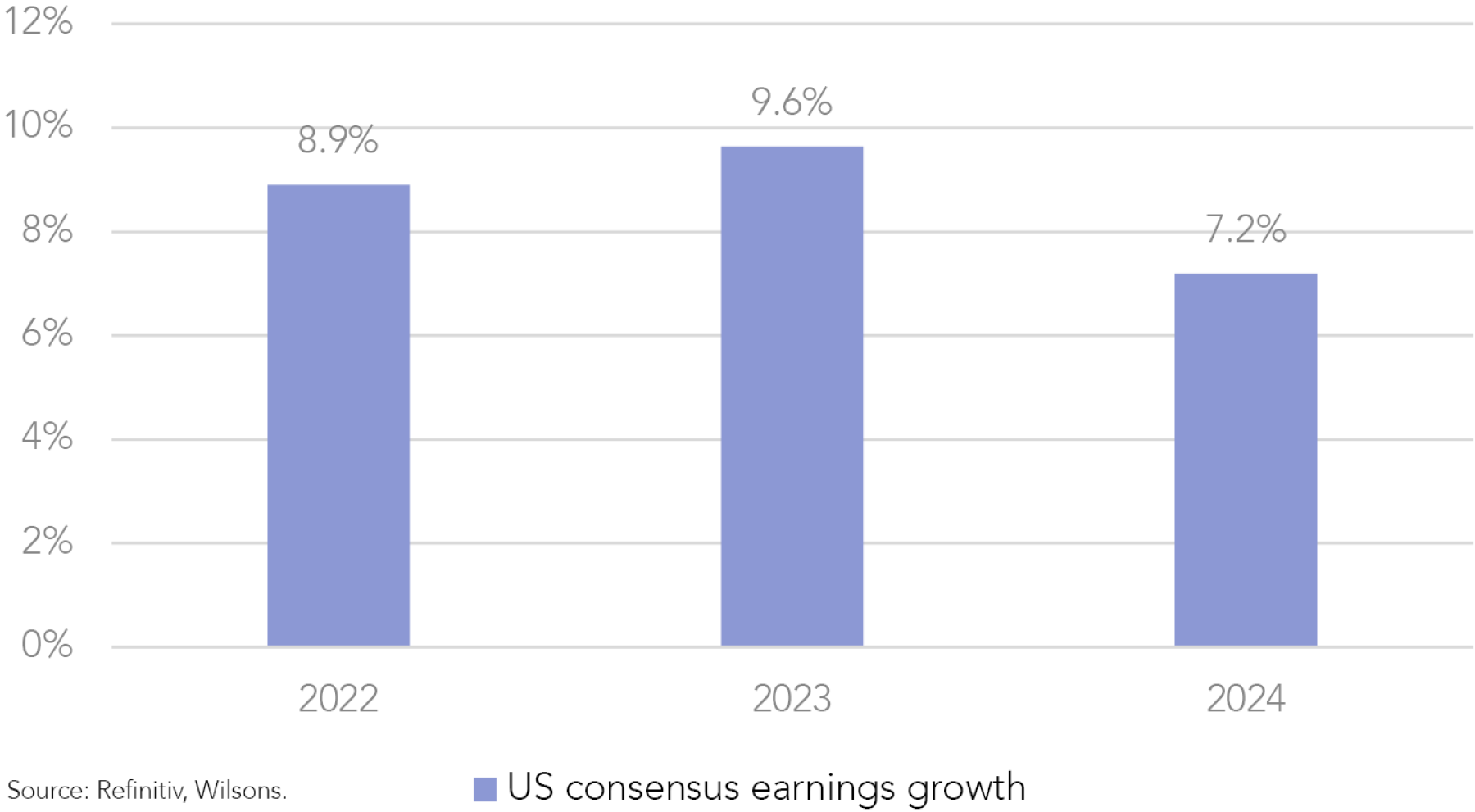
History suggests that stock prices peak when earnings estimates start rolling over decisively. This time around, however, the equity sell-off occurred well ahead of any significant earnings estimate revisions, suggesting that investors have already discounted reasonably significant earnings cuts.
Taking a long-term view, we believe US equity returns will be helped by today’s lower valuations. In the near-term, though, they remain vulnerable to profit cuts, with margins likely to have peaked. Additionally, they may face headwinds from higher interest rates. This is particularly concerning for the US market, which is heavily weighted towards long-duration growth stocks.
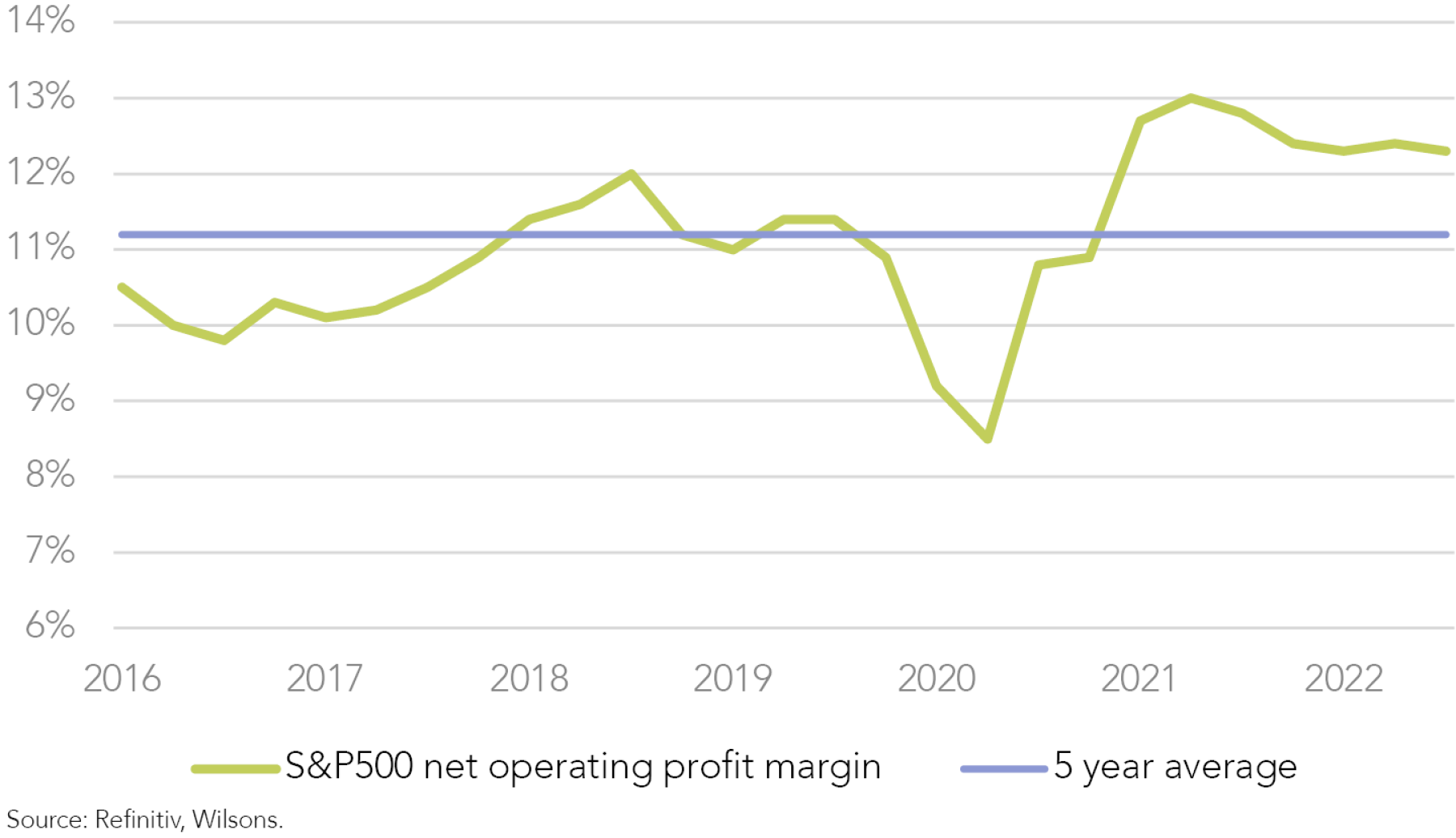
Keeping an Eye on Bond Yields
At the market’s peak in January, the 10-year treasury yield stood at 1.50%; today, it is 3.40%. The result is that valuations have lost some of that low interest rate support. Given that stocks are a claim on future corporate cash flows, higher interest rates reduce the present value of those claims and (all things equal) therefore lead to lower stock prices. Once inflation and bond yields have convincingly peaked, we can gain more comfort that rising rates will no longer present a headwind to risk asset valuations. If inflation moderates in the coming months, as we expect, then the Fed will not need to adopt a more aggressive pace of rate hikes than it has already communicated.
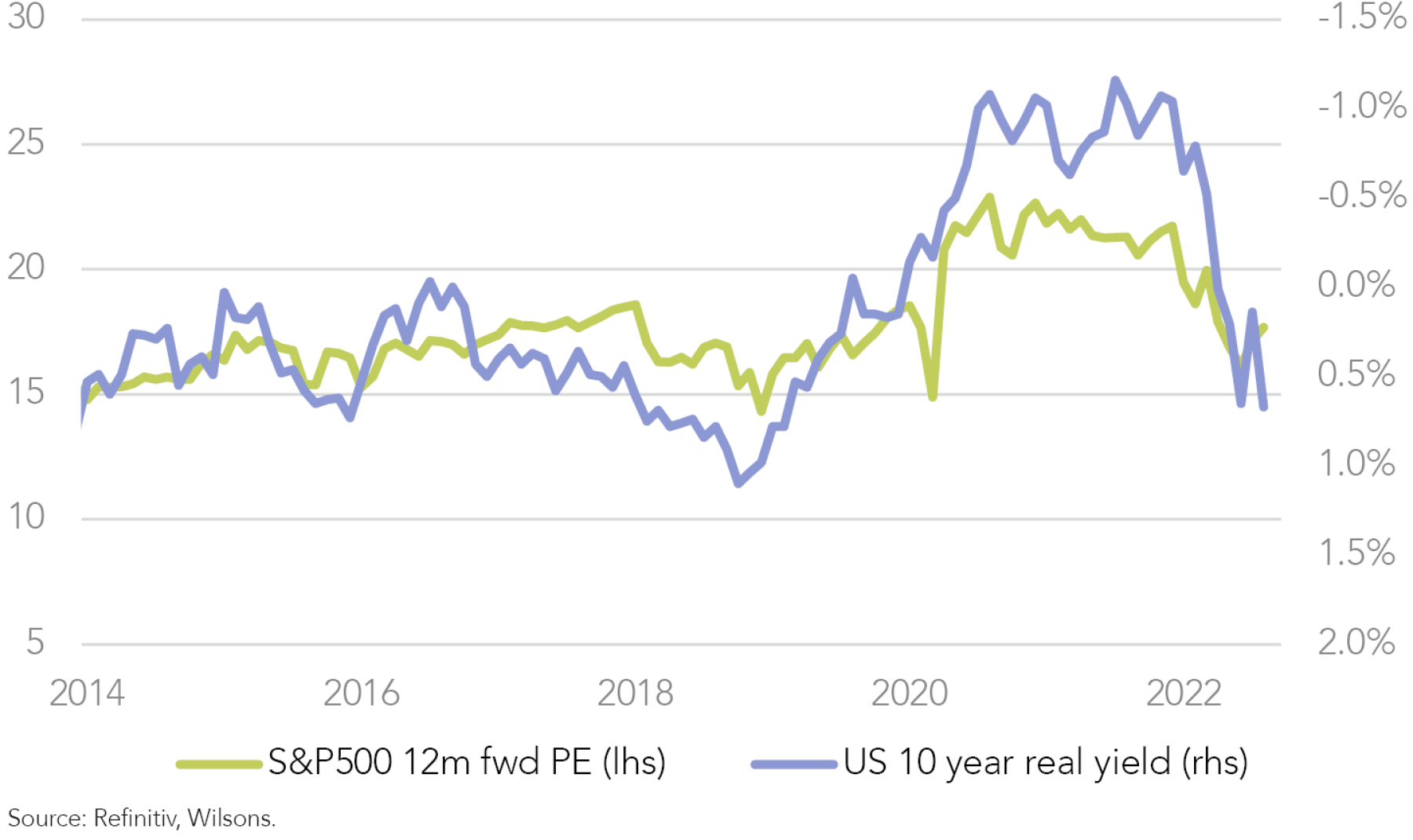
On a relative basis, stocks still look attractive when compared to the real return potential of bonds, given current yields. The S&P 500 still looks fairly valued relative to yields, trading close to the long-term average spread between the forward earnings yield and the real 10-year bond yield.
Figure 6 shows how this spread has moved over the last 20 years. During periods of stress and uncertainty, such as the GFC, the trade war in 2019 and the Covid selloff in March 2020, there is a wider risk premium, whereas during less volatile periods for markets, such as through 2017, it is not unusual to see the spread compress, as investors allocate more to stocks.
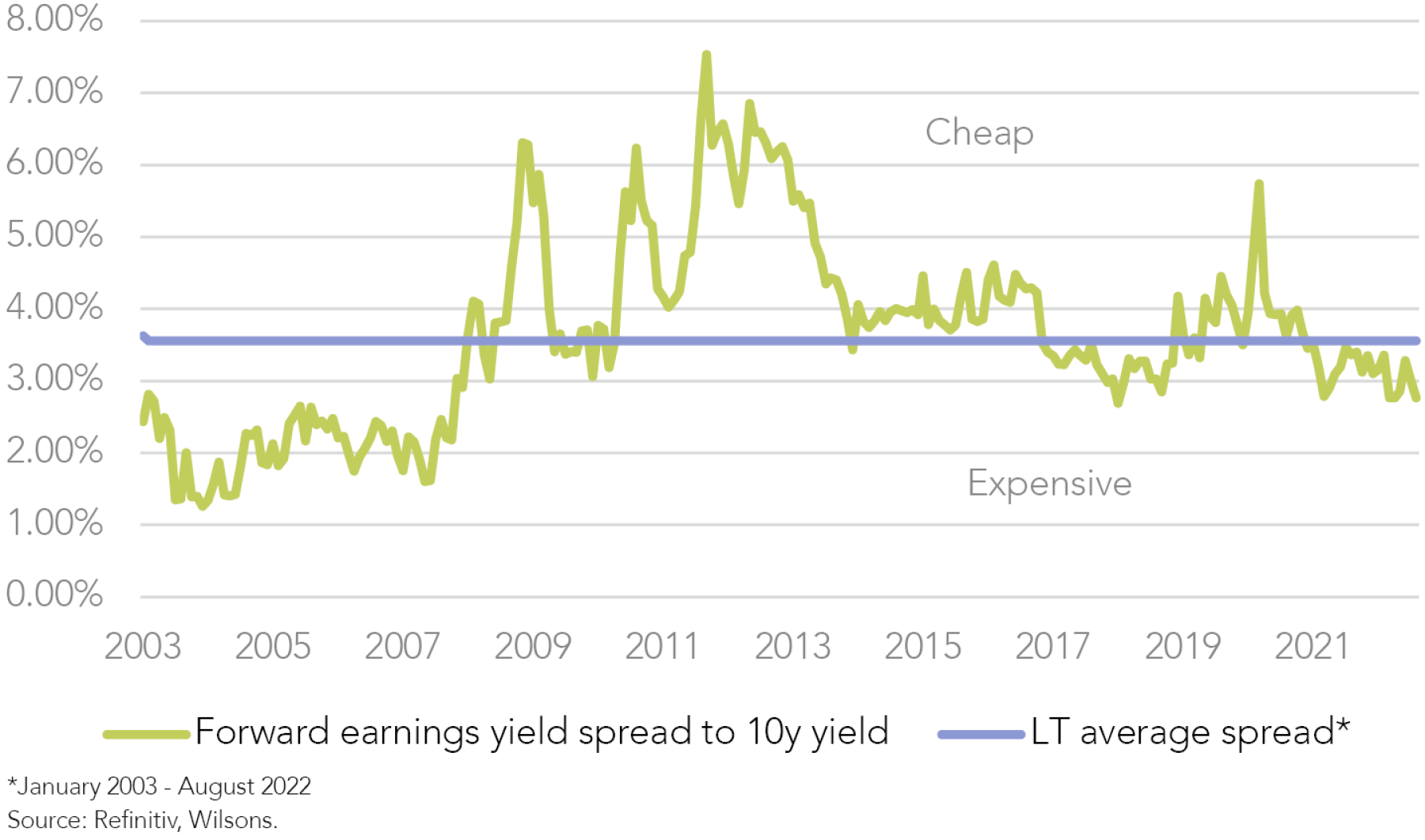
Over the last year, real yields near -1% were consistent with the forward PE multiple closer to 22x. Looking further back, real yields from 2014 to 2019 in the 0-1% range appeared consistent with forward PE multiples in the 16x to 18x range. Over the long-term, we expect real yields to edge lower again, which could put some upward pressure on multiples. However, in the short-term environment, characterised by higher real yields, stocks may continue to trade at relatively lower multiples.
Non US Markets Face their own Economic Headwinds
Although valuations are more appealing outside the US, the Euro zone and emerging markets – which together make up a large portion of the global index – are facing their own significant set of challenges.
European multiples already reflect stagflation fears, with the region facing a high risk of recession as the energy squeeze caused by sanctions on Russia is felt by the wider economy. Meanwhile, inflationary pressures are compelling the European Central Bank (ECB) to tighten policy amid a weakening economic backdrop. The ECB is a laggard when it comes to monetary tightening, and could find itself playing catch-up. If this is the case, rising interest rates will likely cap the upside to equity valuations in the near-term. Emerging market equities look cheap but also remain susceptible to weakening global growth and the uncertainty surrounding the Chinese property market.
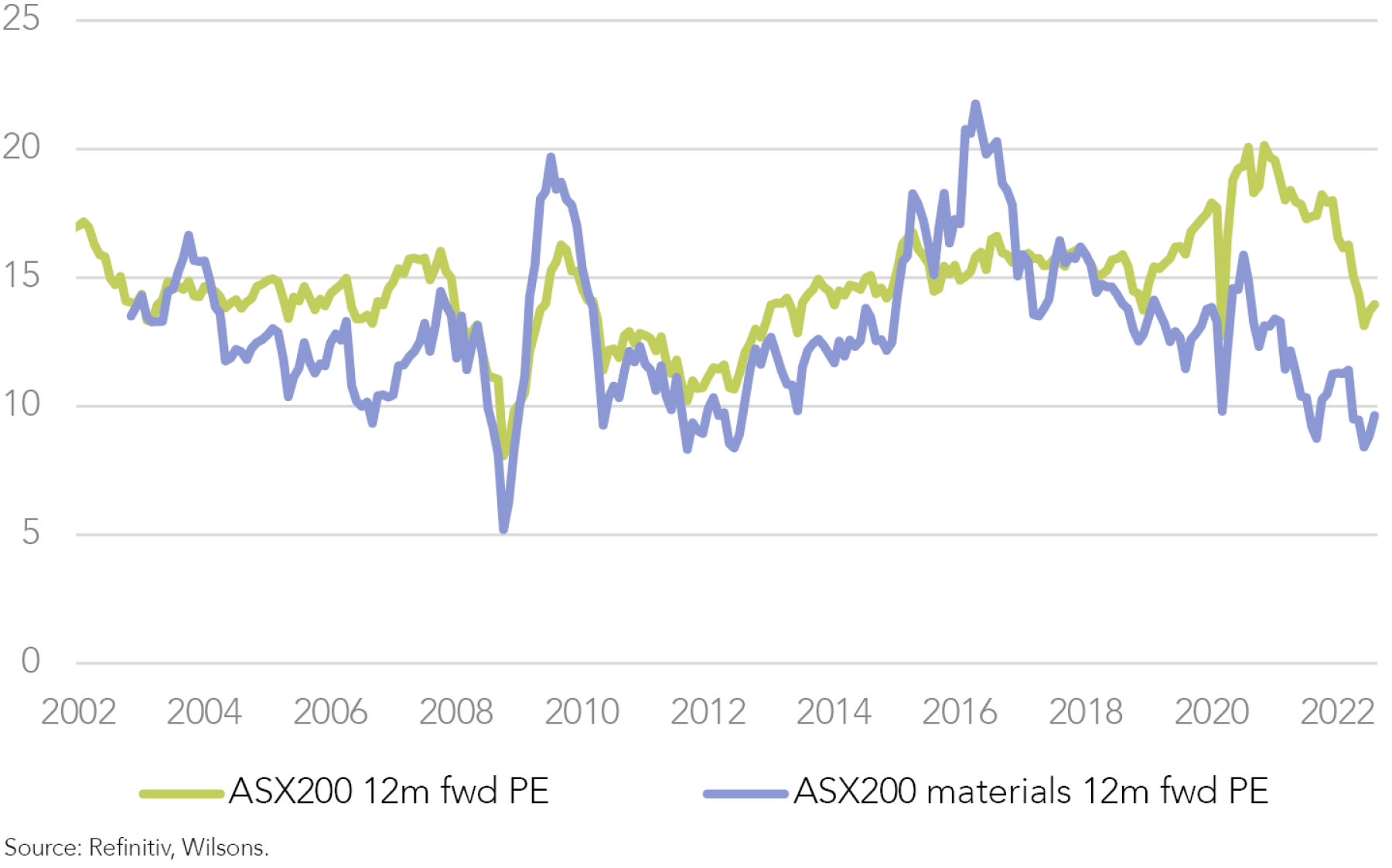
What about Australian Valuations?
Australian valuations experienced one of the largest reversals of any major market, down 30% from the peak in December 2020 on a forward-PE-ratio basis (and down 15% this year). The market currently looks undervalued relative to its own long-term average and appears attractive compared to global peers. Buoyant earnings in the resource sector likely overstate Australia’s valuation appeal to a degree, but we think domestic valuations are at least fair.
As already stated, although valuations are a key signal over the long-term, they are just one piece of the puzzle, along with factors like monetary and fiscal policy, the near-term economic outlook, sentiment and positioning. Understanding how these factors evolve through the cycle and what investment horizon they provide signals for is helpful in determining the weight to give them. Lower valuations partially reflect the rising interest rate environment and concerns that earnings will be subject to significant downward revisions reflecting slowing growth. We remain neutral on equities, waiting for a confirmation of a sustained cooling in inflation and policy hawkishness before considering an upgrade.

Written by
David Cassidy, Head of Investment Strategy
David is one of Australia’s leading investment strategists.
About Wilsons Advisory: Wilsons Advisory is a financial advisory firm focused on delivering strategic and investment advice for people with ambition – whether they be a private investor, corporate, fund manager or global institution. Its client-first, whole of firm approach allows Wilsons Advisory to partner with clients for the long-term and provide the wide range of financial and advisory services they may require throughout their financial future. Wilsons Advisory is staff-owned and has offices across Australia.
Disclaimer: This communication has been prepared by Wilsons Advisory and Stockbroking Limited (ACN 010 529 665; AFSL 238375) and/or Wilsons Corporate Finance Limited (ACN 057 547 323; AFSL 238383) (collectively “Wilsons Advisory”). It is being supplied to you solely for your information and no action should be taken on the basis of or in reliance on this communication. To the extent that any information prepared by Wilsons Advisory contains a financial product advice, it is general advice only and has been prepared by Wilsons Advisory without reference to your objectives, financial situation or needs. You should consider the appropriateness of the advice in light of your own objectives, financial situation and needs before following or relying on the advice. You should also obtain a copy of, and consider, any relevant disclosure document before making any decision to acquire or dispose of a financial product. Wilsons Advisory's Financial Services Guide is available at wilsonsadvisory.com.au/disclosures.
All investments carry risk. Different investment strategies can carry different levels of risk, depending on the assets that make up that strategy. The value of investments and the level of returns will vary. Future returns may differ from past returns and past performance is not a reliable guide to future performance. On that basis, any advice should not be relied on to make any investment decisions without first consulting with your financial adviser. If you do not currently have an adviser, please contact us and we would be happy to connect you with a Wilsons Advisory representative.
To the extent that any specific documents or products are referred to, please also ensure that you obtain the relevant disclosure documents such as Product Disclosure Statement(s), Prospectus(es) and Investment Program(s) before considering any related investments.
Wilsons Advisory and their associates may have received and may continue to receive fees from any company or companies referred to in this communication (the “Companies”) in relation to corporate advisory, underwriting or other professional investment services. Please see relevant Wilsons Advisory disclosures at www.wilsonsadvisory.com.au/disclosures.
